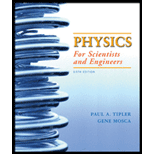
Concept explainers
(a)
The proof that
(a)
Answer to Problem 65P
It is proved that
Explanation of Solution
Formula used:
The expression for the final velocity of first object is given by,
The expression for the final velocity of second object is given by,
Calculation:
The expression for the final velocity of first object is calculated as,
The expression for the final velocity of second object is given by,
Conclusion:
Therefore, It is proved that
(b)
The proof that
(b)
Answer to Problem 65P
It is proved that
Explanation of Solution
Calculation:
The expression for the final velocity of first object is calculated as,
Further simplify the above,
The expression for the final velocity of second object is given by,
Further simplify the above,
Conclusion:
Therefore, it is proved that
(c)
The proof that
(c)
Answer to Problem 65P
It is proved that
Explanation of Solution
Calculation:
The expression for the final velocity of first object is calculated as,
Further simplify the above,
The expression for the final velocity of second object is given by,
Further simplify the above,
Conclusion:
Therefore, it is proved that
Want to see more full solutions like this?
Chapter 8 Solutions
EBK PHYSICS FOR SCIENTISTS AND ENGINEER
- An object is placed 24.1 cm to the left of a diverging lens (f = -6.51 cm). A concave mirror (f= 14.8 cm) is placed 30.2 cm to the right of the lens to form an image of the first image formed by the lens. Find the final image distance, measured relative to the mirror. (b) Is the final image real or virtual? (c) Is the final image upright or inverted with respect to the original object?arrow_forwardConcept Simulation 26.4 provides the option of exploring the ray diagram that applies to this problem. The distance between an object and its image formed by a diverging lens is 5.90 cm. The focal length of the lens is -2.60 cm. Find (a) the image distance and (b) the object distance.arrow_forwardPls help ASAParrow_forward
 University Physics Volume 3PhysicsISBN:9781938168185Author:William Moebs, Jeff SannyPublisher:OpenStax
University Physics Volume 3PhysicsISBN:9781938168185Author:William Moebs, Jeff SannyPublisher:OpenStax Classical Dynamics of Particles and SystemsPhysicsISBN:9780534408961Author:Stephen T. Thornton, Jerry B. MarionPublisher:Cengage Learning
Classical Dynamics of Particles and SystemsPhysicsISBN:9780534408961Author:Stephen T. Thornton, Jerry B. MarionPublisher:Cengage Learning Modern PhysicsPhysicsISBN:9781111794378Author:Raymond A. Serway, Clement J. Moses, Curt A. MoyerPublisher:Cengage Learning
Modern PhysicsPhysicsISBN:9781111794378Author:Raymond A. Serway, Clement J. Moses, Curt A. MoyerPublisher:Cengage Learning Physics for Scientists and Engineers: Foundations...PhysicsISBN:9781133939146Author:Katz, Debora M.Publisher:Cengage Learning
Physics for Scientists and Engineers: Foundations...PhysicsISBN:9781133939146Author:Katz, Debora M.Publisher:Cengage Learning University Physics Volume 1PhysicsISBN:9781938168277Author:William Moebs, Samuel J. Ling, Jeff SannyPublisher:OpenStax - Rice University
University Physics Volume 1PhysicsISBN:9781938168277Author:William Moebs, Samuel J. Ling, Jeff SannyPublisher:OpenStax - Rice University Principles of Physics: A Calculus-Based TextPhysicsISBN:9781133104261Author:Raymond A. Serway, John W. JewettPublisher:Cengage Learning
Principles of Physics: A Calculus-Based TextPhysicsISBN:9781133104261Author:Raymond A. Serway, John W. JewettPublisher:Cengage Learning





